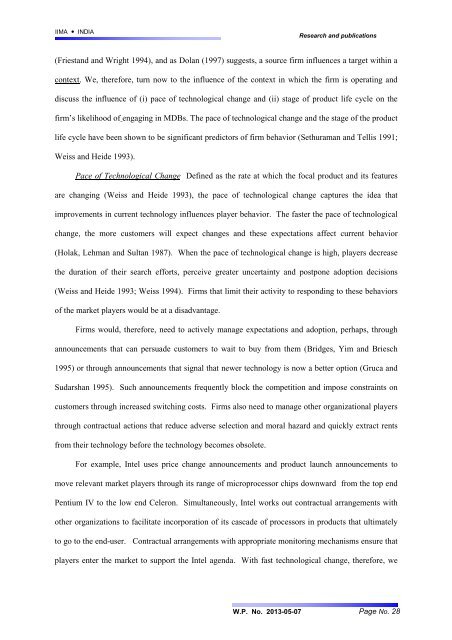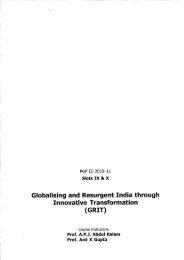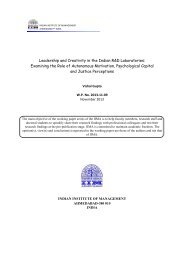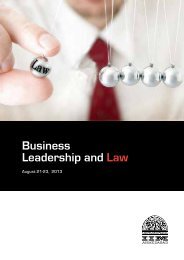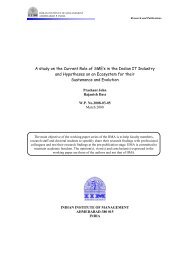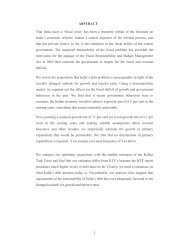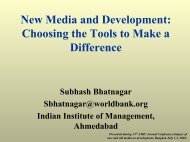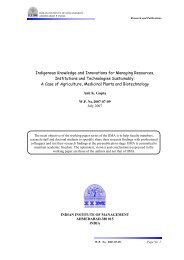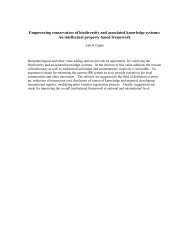to Download (English) File - Indian Institute of Management ...
to Download (English) File - Indian Institute of Management ...
to Download (English) File - Indian Institute of Management ...
Create successful ePaper yourself
Turn your PDF publications into a flip-book with our unique Google optimized e-Paper software.
IIMA INDIA<br />
Research and publications<br />
(Friestand and Wright 1994), and as Dolan (1997) suggests, a source firm influences a target within a<br />
context. We, therefore, turn now <strong>to</strong> the influence <strong>of</strong> the context in which the firm is operating and<br />
discuss the influence <strong>of</strong> (i) pace <strong>of</strong> technological change and (ii) stage <strong>of</strong> product life cycle on the<br />
firm’s likelihood <strong>of</strong> engaging in MDBs. The pace <strong>of</strong> technological change and the stage <strong>of</strong> the product<br />
life cycle have been shown <strong>to</strong> be significant predic<strong>to</strong>rs <strong>of</strong> firm behavior (Sethuraman and Tellis 1991;<br />
Weiss and Heide 1993).<br />
Pace <strong>of</strong> Technological Change Defined as the rate at which the focal product and its features<br />
are changing (Weiss and Heide 1993), the pace <strong>of</strong> technological change captures the idea that<br />
improvements in current technology influences player behavior. The faster the pace <strong>of</strong> technological<br />
change, the more cus<strong>to</strong>mers will expect changes and these expectations affect current behavior<br />
(Holak, Lehman and Sultan 1987). When the pace <strong>of</strong> technological change is high, players decrease<br />
the duration <strong>of</strong> their search efforts, perceive greater uncertainty and postpone adoption decisions<br />
(Weiss and Heide 1993; Weiss 1994). Firms that limit their activity <strong>to</strong> responding <strong>to</strong> these behaviors<br />
<strong>of</strong> the market players would be at a disadvantage.<br />
Firms would, therefore, need <strong>to</strong> actively manage expectations and adoption, perhaps, through<br />
announcements that can persuade cus<strong>to</strong>mers <strong>to</strong> wait <strong>to</strong> buy from them (Bridges, Yim and Briesch<br />
1995) or through announcements that signal that newer technology is now a better option (Gruca and<br />
Sudarshan 1995). Such announcements frequently block the competition and impose constraints on<br />
cus<strong>to</strong>mers through increased switching costs. Firms also need <strong>to</strong> manage other organizational players<br />
through contractual actions that reduce adverse selection and moral hazard and quickly extract rents<br />
from their technology before the technology becomes obsolete.<br />
For example, Intel uses price change announcements and product launch announcements <strong>to</strong><br />
move relevant market players through its range <strong>of</strong> microprocessor chips downward from the <strong>to</strong>p end<br />
Pentium IV <strong>to</strong> the low end Celeron. Simultaneously, Intel works out contractual arrangements with<br />
other organizations <strong>to</strong> facilitate incorporation <strong>of</strong> its cascade <strong>of</strong> processors in products that ultimately<br />
<strong>to</strong> go <strong>to</strong> the end-user. Contractual arrangements with appropriate moni<strong>to</strong>ring mechanisms ensure that<br />
players enter the market <strong>to</strong> support the Intel agenda. With fast technological change, therefore, we<br />
W.P. No. 2013-05-07 Page No. 28


